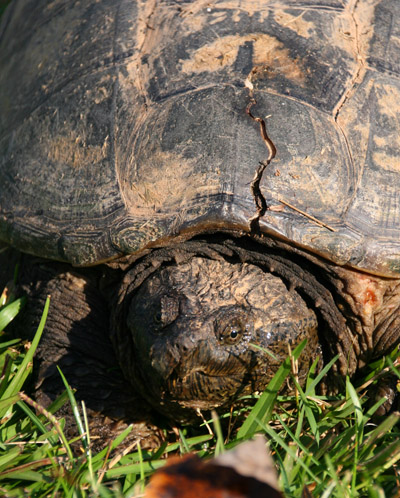 I had another session with the immutable Mr Bugg yesterday, and I figured he’d be trying to scoop me on posting, but here we are. More importantly, I know he can’t show off any images of my subject here, because I encountered it after I dropped him off.
I had another session with the immutable Mr Bugg yesterday, and I figured he’d be trying to scoop me on posting, but here we are. More importantly, I know he can’t show off any images of my subject here, because I encountered it after I dropped him off.
I spotted this common snapping turtle (Chelydra serpentina) heading out from an ornamental pond across the sidewalk as I drove past, and I turned around quickly and headed back, because its path was going to take it directly across the road. By the time I’d parked and gotten out with the camera, it had already made it to the road surface but not yet out into traffic. Getting run over is a common demise for turtles, more often in the spring, as their treks towards mating or egg-laying opportunities carry them across busy roads. On occasion, some helpful passerby will move them from the road, but the important thing is to take them in the direction they were facing and not just to the nearest roadside, since they were going that way for a reason. So while it would have been easy to push this one back into the grass immediately behind it, I carried it instead across all traffic lanes and deposited it in the grass on the far side before getting these images.
And as you can see, this is not its first encounter with traffic, or most likely not at least – that cracked shell, an older injury, almost certainly came from a car, and it has a cracked snout to match, which you’ll get a slightly better view of shortly. My subject, defensively grumpy as the species always is, was not going to pose in the best light angle and I was disinclined to continue stressing it out. By the way, safely handling one of these, the largest turtles we have in the area, takes a little knowledge. Their heads can come a lot further out than we typically see, reaching well over either shoulder, and most distinctly, they do so with lightning speed, sometimes able to dislodge someone’s grip on their shell from the violent nature of it, but also easily able to startle someone into dropping them. The legs also have great digging claws that can be used to fend off typical grips on their carapace, so it takes a certain approach, with varying recommendations across the net. Some people suggest simply gripping the fat tail, while others say this can dislocate the vertabrae – myself, I have never seen nor heard of examples of this, but it never hurts to play it safe. The best suggestion is to scoop it up with a shovel, but not many people have one handy, so the next best is to grasp the rear of the shell on both sides of the tail, which is awkward and doesn’t keep you from the hind legs. For this one, I just used my fingertips to grip the edges of the carapace between the front and rear legs, keeping back from the reach of the head.
Here’s another shot because everyone needs a snapping turtle portrait for their phone backgrounds. But I have to wonder where this little bugger was last week, when it would have been appropriate?





















































